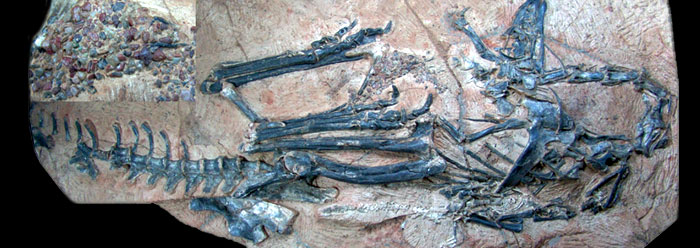A new beak-bearing theropod dinosaur was discovered in China recently, and it supposedly “solves the mystery of dinosaur finger evolution,”1 since its finger bones do not have the same arrangement as those of other theropods. But does this difference adequately answer the evolutionary question about bird phalange origins, or is it another example of hand-picked features for “homology” studies?
Named Limusaurus inextricabilis, the fossil has three fingers anchored to wrist bones 2, 3, and 4 (numbered from the “thumb” to the “pinky”), which is similar to how the three very long bones that extend into bird wings are arranged. This is unlike other theropod dinosaurs, whose finger bones are anchored to 1, 2, and 3 instead. That arrangement has stumped paleontologists who believe that birds are descendants of theropods. Researchers have been confused by the fact that the three long bird digit bones developed from different source points than those of the three theropod finger bones.
Moreover, finger arrangement has been considered a highly important determining factor for establishing evolutionary “homologous” relationships between various kinds. The placement of phalanges has “been widely accepted as the main operational criterion for primary homology.”2 With this new find, scientists believe that they have found the “evolutionary intermediate” between dinosaur hands and bird wings. But have they?
The fingers on this Chinese dinosaur were part of short forelimbs, showing no hint of lengthening in transition toward wings. Thus, although they are anchored to similarly structured wrist bones as that of birds, these dino-fingers do not appear transitional in function at all, but instead were fully suited for its theropod terrestrial life.
Undoubtedly, this bone placement, which is unique in the world of theropods, will fuel more elaborately imagined details of dinosaur-to-bird evolution. However, in the words of evolutionist Alan Feduccia, his colleagues will still have to invent solutions “to explain such problems as the transformation of teeth and tooth replacement, the transformation of a dinosaurian septate [diaphragm-driven] hepatic-piston breathing system to a bird flow-through lung, the complete abandonment of a balanced seesaw body plan to the avian model, and the reelongation of already foreshortened forelimbs, to mention a few.”3
Why has the mere positioning of finger bones been emphasized in this new pronouncement of evolutionary “proof,” instead of hip structure, bone density structure, forelimb length, or any of a number of traits that birds have and dinosaurs did not?
There are many examples of fossilized and living creatures that share one similarity with other kinds and yet have no common lineage on the hypothetical evolutionary tree. One is the Chalicotherium, which had a horse-like head that was attached to a sloth-like body with claws on its thumbs only. Similarly, the platypus lays eggs like a reptile, but it shares other specific features with mammals and even birds. As in these cases, this new find does not represent a transition but was simply a created dinosaur with unique finger bone positioning, and not a transition at all.
Even researcher James Clark, who published the find in Nature, tacitly admitted that this is not conclusive enough evidence, since this beak-bearing dinosaur’s hand bones are “not going to stop the debate.”1 If evidence clearly showed a dinosaur to bird transition, there should no longer be a debate. But it doesn’t at all, so the debate will continue.
There are many insurmountable obstacles that evolution would have had to overcome in converting theropods to birds, and almost none of the key transitional changes are recorded in the fossil record. Going by the evidence, it seems that dinosaurs and birds were made purposively and distinctly as separate creatures. http://www.icr.org/article/do-new-dinosaur-finger-bones-solve/
References
- Bryner, J. Fossil Solves Mystery of Dinosaur Finger Evolution. LiveScience. Posted on livescience.com June 17, 2009, accessed June 19, 2009.
- Xu, X. et al. 2009. A Jurassic ceratosaur from China helps clarify avian digital homologies. Nature. 459 (7249): 942.
- Feduccia, A. 1999. 1,2,3 = 2,3,4: Accomodating the cladogram. Proceedings of the National Academy of Sciences. 96 (9): 4742.
Image Credit: Nature
* Mr. Thomas is Science Writer at the Institute for Creation Research.
Also see:
Have Scientists Finally Found 'Dinofuzz'?
Archaeopteryx Is a Bird. . . Again
Is New Fossil a Bird-Eating Dinosaur?
Study Fails to Prove Flight Feathers Evolved
“Evolution” of Finch Beaks—Again
